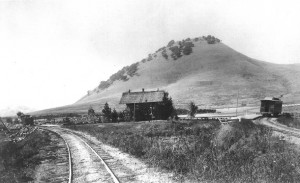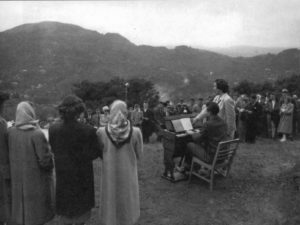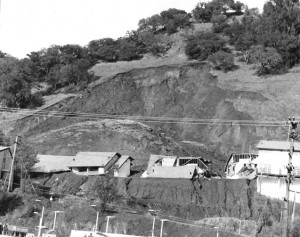Red Hill is a San Anselmo landmark, filling the view when approaching town from any direction. What the Native Americans inhabitants of Marin called our prominent hill is now lost, though they certainly lived in the San Anselmo area, as a number of artifacts have been found here. The Spanish called the red hill Pan de Azúcar, or Sugar Loaf, from its resemblance to the conical blocks in which sugar was then sold.

Red Hill, 1875
In the 1890s Dr. Henry DuBois, owner of Mt. Tamalpais Cemetery, constructed a zig-zag dirt road up the westside of Red Hill. From 1929 to 1953, it was a tradition for folks to hike to the top before daylight on Easter Sunday for religious services as the sun rose over Mount Diablo and the Bay. A 20-foot-tall wooden cross was erected at the summit and illuminated. The summit was also a popular picnic site.

Easter Sunrise Service, 1949 (Marin History Museum)
The road to the summit fell into disrepair. The two lowest switchbacks eroded and became impassible, and the upper ones were overgrown with non-native broom, acacia, and eucalyptus. In January 1967, a large landslide on the south side of the hill destroyed a row of newly-constructed, unoccupied apartment buildings.

Red Hill Slide, 1967
The only way to enjoy the views from the summit was to bushwhack through thick undergrowth, then scramble straight up the hillside on all fours. Only the hardiest hikers ever attempted it. The views from the summit were as spectacular as ever, but it was nearly inaccessible. Residents saw Red Hill every day, but very few had ever been there.
In 2013, the San Anselmo Open Space Committee undertook a project to restore access to this historic hill. They sought and received the approval of the Town Council to build a trail to the top and a sister trail along the top of Memorial Ridge on the other side of the valley, connecting Sorich Park through Mount Tamalpais Cemetery to Memorial Park. They cleared the brush from the overgrown switchbacks, pulled invasive broom, removed fallen trees, and hauled out many bags of litter.
But the lower section of the old road was completely gone, slid away in innumerable landslides. An alternate route was needed. Sunny Hills Services, owner of the northwestern portion of the hill and the direct descendant of the San Francisco Presbyterian Orphanage, kindly offered a long-term lease of their land and permission to build a trail to access DuBois’s road. The San Anselmo Historical Commission researched the history of Red Hill and helped create the interpretive signs.

